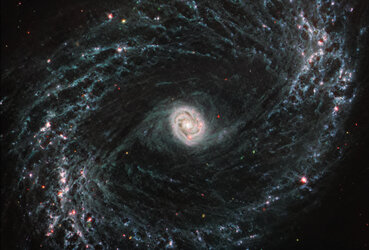Accept all cookies Accept only essential cookies See our Cookie Notice

About ESA
The European Space Agency (ESA) is Europe’s gateway to space. Its mission is to shape the development of Europe’s space capability and ensure that investment in space continues to deliver benefits to the citizens of Europe and the world.
Highlights
ESA - United space in Europe
This is ESA ESA facts Member States & Cooperating States Funding Director General Top management For Member State Delegations European vision European Space Policy ESA & EU Space Councils Responsibility & Sustainability Annual Report Calendar of meetings Corporate newsEstablishments & sites
ESA Headquarters ESA ESTEC ESA ESOC ESA ESRIN ESA EAC ESA ESAC Europe's Spaceport ESA ESEC ESA ECSAT Brussels Office Washington OfficeWorking with ESA
Business with ESA ESA Commercialisation Gateway Law at ESA Careers Cyber resilience at ESA IT at ESA Newsroom Partnerships Merchandising Licence Education Open Space Innovation Platform Integrity and Reporting Administrative Tribunal Health and SafetyMore about ESA
History ESA Historical Archives Exhibitions Publications Art & Culture ESA Merchandise Kids Diversity ESA Brand Centre ESA ChampionsLatest
Space in Member States
Find out more about space activities in our 23 Member States, and understand how ESA works together with their national agencies, institutions and organisations.
Science & Exploration
Exploring our Solar System and unlocking the secrets of the Universe
Go to topicAstronauts
Missions
Juice Euclid Webb Solar Orbiter BepiColombo Gaia ExoMars Cheops Exoplanet missions More missionsActivities
International Space Station Orion service module Gateway Concordia Caves & Pangaea BenefitsLatest
Space Safety
Protecting life and infrastructure on Earth and in orbit
Go to topicAsteroids
Asteroids and Planetary Defence Asteroid danger explained Flyeye telescope: asteroid detection Hera mission: asteroid deflection Near-Earth Object Coordination CentreSpace junk
About space debris Space debris by the numbers Space Environment Report In space refuelling, refurbishing and removingSafety from space
Clean Space ecodesign Zero Debris Technologies Space for Earth Supporting Sustainable DevelopmentLatest
Applications
Using space to benefit citizens and meet future challenges on Earth
Go to topicObserving the Earth
Observing the Earth Future EO Copernicus Meteorology Space for our climate Satellite missionsCommercialisation
ESA Commercialisation Gateway Open Space Innovation Platform Business Incubation ESA Space SolutionsLatest
Enabling & Support
Making space accessible and developing the technologies for the future
Go to topicBuilding missions
Space Engineering and Technology Test centre Laboratories Concurrent Design Facility Preparing for the future Shaping the Future Discovery and Preparation Advanced Concepts TeamSpace transportation
Space Transportation Ariane Vega Space Rider Future space transportation Boost! Europe's Spaceport Launches from Europe's Spaceport from 2012Latest

NGC 1365 (MIRI image)
Thank you for liking
You have already liked this page, you can only like it once!
Scientists are getting their first look with the NASA/ESA/CSA James Webb Space Telescope’s powerful resolution at how the formation of young stars influences the evolution of nearby galaxies. NGC 1365, observed here by Webb’s Mid-Infrared Instrument (MIRI) is one of a total of 19 galaxies targeted for study by the Physics at High Angular resolution in Nearby Galaxies (PHANGS) collaboration.
As revealed by the MIRI observations of NGC 1365, clumps of dust and gas in the interstellar medium have absorbed the light from forming stars and emitted it back out in the infrared, lighting up an intricate network of cavernous bubbles and filamentary shells influenced by young stars releasing energy into the galaxy’s spiral arms.
Webb’s exquisite resolution also picks up several extremely bright star clusters not far from the core and newly observed recently formed clusters along the outer edges of the spiral arms.
Additionally, the Webb images provide insights into how the orbits of stars and gas vary depending on where they form, and how this results in the population of older clusters outside the inner star-formation ring.
NGC 1365 is a double-barred spiral galaxy that lies about 56 million light-years away from Earth. It’s one of the largest galaxies currently known to astronomers, spanning twice the length of the Milky Way. In this image of NGC 1356, blue, green, and red were assigned to Webb’s MIRI data at 7.7, 10 and 11.3, and 21 microns (the F770W, F1000W and F1130W, and F2100W filters, respectively).
MIRI was contributed by ESA and NASA, with the instrument designed and built by a consortium of nationally funded European Institutes (The MIRI European Consortium) and NASA’s Jet Propulsion Laboratory, in partnership with the University of Arizona.
[Image Description: A large spiral galaxy takes up the entirety of the image, with the lower right portion of the galaxy’s spiral arms extending out of frame. The core of the galaxy is just off center to the lower right of the image. The bright core is an elongated oval with narrow, diffuse arms extending a short way out each narrow end of the oval. The main spiral arm to the upper left of the core is waspy and highlights filaments of dust around cavernous black bubbles.]
-
CREDIT
NASA, ESA, CSA, and J. Lee (NOIRLab), A. Pagan (STScI) -
LICENCE
ESA Standard Licence

NGC 1433 (MIRI image)

NGC 1365

NGC 7496 (MIRI image)

Cartwheel Galaxy (MIRI)















 Germany
Germany
 Austria
Austria
 Belgium
Belgium
 Denmark
Denmark
 Spain
Spain
 Estonia
Estonia
 Finland
Finland
 France
France
 Greece
Greece
 Hungary
Hungary
 Ireland
Ireland
 Italy
Italy
 Luxembourg
Luxembourg
 Norway
Norway
 The Netherlands
The Netherlands
 Poland
Poland
 Portugal
Portugal
 Czechia
Czechia
 Romania
Romania
 United Kingdom
United Kingdom
 Slovenia
Slovenia
 Sweden
Sweden
 Switzerland
Switzerland

























